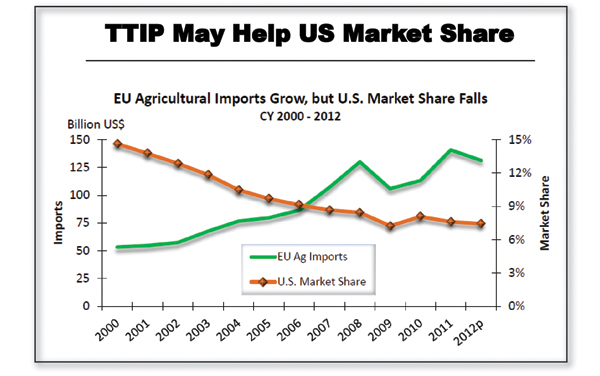California Agricultural Technology Institute
New global trade agreements could offer boost to California agricultural producers
Potential new trade agreements involving nations all over the globe could have significant positive impacts on agricultural producers in California’s Central Valley, as well as throughout California and the United States, according to a recent report by a Fresno State economist.
U.S. Trade representatives have been conducting trade talks with potential partners over the last year with the hope of cementing two new pacts called the Trans Pacific Partnership (TPP) and the Transatlantic Trade and Investment Partnership (TTIP). The new deals would reduce certain high tariffs and relax regulations that have blocked U.S. imports into other countries. In turn the United States would open up more avenues for imports from those countries.
“Export markets are critical to the success of Central Valley agriculture,” stated Mickey Paggi, director of Fresno State’s Center for Agricultural Business (CAB), in a recent address to a USDA agricultural trade research committee in New Orleans. For example, of many of the top-value crops grown in the Central Valley in 2012, for seven of them more than 50 percent of production went for international export. Those crops included pistachios, almonds, walnuts, dried plums, grapefruit, blueberries and rice.
“The TPP and TTIP negotiations are now the main trade policy focus of the Obama Administration,” Paggi said. “They would be the two most important trade agreements to be negotiated since NAFTA.”

Why? Potential new transpacific partners encompass a market of nearly 500 million consumers with a combined gross domestic product (GDP) of nearly $12 trillion. Those countries include Canada, Australia, Mexico, Malaysia, Singapore, Chile, Peru, New Zealand, Vietnam, Brunei and Japan.
The transatlantic group spans 28 countries with another 500 million consumers and a GDP of more than $16 trillion.
Existing agreements such as NAFTA have already enhanced trade with our north and south bordering neighbors, Paggi noted. The TPP would expand the NAFTA pool of partners and further upgrade U.S. producers’ opportunities to both export and import. The value of U.S. exports is projected to rise from about $500 billion annually under NAFTA to nearly $700 billion yearly under the TPP. Imports also could increase from annual values of $600 billion under NAFTA to more than $800 billion under the TPP.
With Japan added to the TPP, California agriculture would stand to gain significant opportunities, Paggi noted. “With the third largest economy in the world, Japan is already the world’s largest importer of agricultural products, including cotton, corn, soybeans, meats, vegetables and fruits,” he said. “Lower trade barriers could lead to expanded imports of beef, rice, wheat, dairy products and sugar.”
As examples of current trade barriers with Japan, Paggi noted that country’s tariffs of 38 percent on beef, 328 percent on sugar and a staggering 778 percent on rice.
Top 10 imports of California-produced products into Japan include rice, almonds, beef and beef products, hay, wine, oranges and orange products, dairy products, walnuts, raisins and lemons.
Japan is not an automatic addition to the TPP, Paggi warned. Approval of the pact in that country will require domestic reform.

The transatlantic agreement (TTIP) could give U.S. agricultural exports a needed boost in market share in the European Union (EU), Paggi noted. While EU agricultural imports have continued to grow over the last decade, the products have not come from the United States. In fact, since 2003 the annual value of U.S. farm products to the EU has decreased from more than $125 billion to just over $75 billion, a five percent loss in market share.
“Tariff reductions on selected U.S. agricultural products could help U.S. market access,” Paggi said. Currently the EU imposes tariffs of 57.6 percent on U.S. dairy products, 28.3 percent on sugars and confectionery, 24.3 percent on animal products, 21.8 percent on beverages and tobacco, and 20.3 percent on cereals and preparations.
Besides tariffs, another hurdle for U.S. producers is food safety regulations. For example, the Europeans do not like the hormone-supplemented feed practices of U.S. producers and so have placed strict controls on beef and related products.
To achieve agreements on both the TPP and TTIP requires U.S. negotiators to stay engaged in a process of give and take. “Trade agreements promote economic well being, and economic stability promotes political stability,” Paggi said. “We should not let the perfect hold the possible hostage.”
For more details related to this report or other CAB economics research, visit the CAB website at www.csufcab.com or contact Paggi at mpaggi@csufresno.edu.